How to Upload Mmd Models Into Other Software
![]() How tin I rip models from One-half-Life 2 into MMD? What programs practise I need beside Blender to import models?
How tin I rip models from One-half-Life 2 into MMD? What programs practise I need beside Blender to import models?
Make your own ripped models
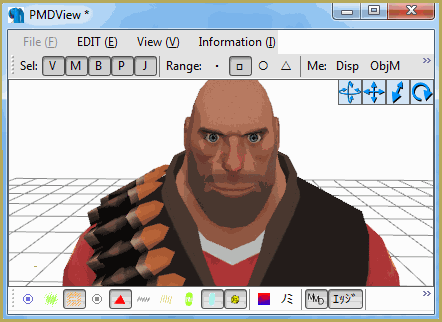
You sissies got new sheriff here, and I won't have no nonsense from ya, got it?
Recently, ZoidsFanatic already published an article about importing models from .OBJ files, which gives us a taste of using Blender as a medium to import models we like into MMD-friendly format with minimal effort. Just what if some very item model you wish to apply is merely non available as an .OBJ? Manifestly, you'd have to use more than superstructure around Blender to brand your model exactly from the source you lot need. In this article nosotros'll explore a process of importing models from Valve's games family based on Source engine.
Footstep 0: prepare Blender
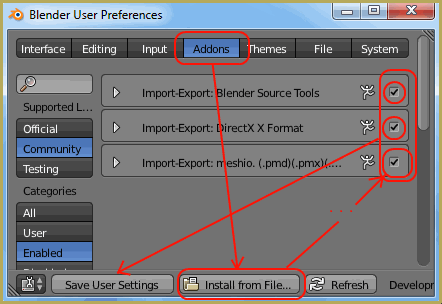 First, you need to download and install Blender. I recommend y'all to employ the latest version (you really do *not* need an boosted plugin to export .X accessories, so no need to have an obsolete install but for that). So you will also need two import/export plugins. In that location'southward no Blender plugin for importing models straight from the proprietary .MDL format that Source games use (at least, to my noesis), so we'll have to resort to ane more intermediate transaction. The plugin we'll use for input is Blender Source Tools, which feeds on .SMD files that ofttimes piece of work as a middleman between various 3D modeling formats. For output, we'll need pymeshio plugin that produces .PMD and PMX files. Download both plugins, launch Blender, select File->User Preferences->Addons, and click Install from File. Find 1 of .zip'southward you downloaded and install it, then exercise the same for another. Afterwards that, find both titles in the list of installed plugins (it will be a lot longer than presented in the filtered screenshot in a higher place) and enable them. Look some time for them to activate, and you lot're adept to go.
First, you need to download and install Blender. I recommend y'all to employ the latest version (you really do *not* need an boosted plugin to export .X accessories, so no need to have an obsolete install but for that). So you will also need two import/export plugins. In that location'southward no Blender plugin for importing models straight from the proprietary .MDL format that Source games use (at least, to my noesis), so we'll have to resort to ane more intermediate transaction. The plugin we'll use for input is Blender Source Tools, which feeds on .SMD files that ofttimes piece of work as a middleman between various 3D modeling formats. For output, we'll need pymeshio plugin that produces .PMD and PMX files. Download both plugins, launch Blender, select File->User Preferences->Addons, and click Install from File. Find 1 of .zip'southward you downloaded and install it, then exercise the same for another. Afterwards that, find both titles in the list of installed plugins (it will be a lot longer than presented in the filtered screenshot in a higher place) and enable them. Look some time for them to activate, and you lot're adept to go.
Pace one: unpack .MDL game files
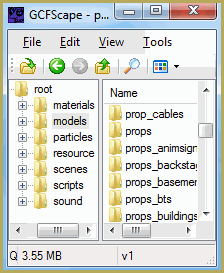 Some of Source games do not pack their files into archives; if so, you tin can skip this step. For others, yous'll accept to unpack them start using GCFScape, one of "Nem'southward tools" package. Launch it, and so detect and open the directory file that contains file structure for the whole multi-function archive (in Portal 2's case, it volition be called "pak01_dir.vpk", just at that place might be other variations). Models will be in the "models" folder (aside from .MDL files, at that place volition be .VVD, .VTX and probably some more files with same kickoff names, and you volition demand them all), and textures will be .VTF files in "materials/models" folder. Folder trees of these two trunks will be similar, simply not necessarily the same, and file names for models and corresponding textures might differ. In that location might be some models that use several textures, and models that share certain textures; more that, models themselves might be represented past several .mdl files, some of which would be useful to you, and others not. You can find and export those files you need, or y'all can export both trunks in toto and then look for what you need after (recommended).
Some of Source games do not pack their files into archives; if so, you tin can skip this step. For others, yous'll accept to unpack them start using GCFScape, one of "Nem'southward tools" package. Launch it, and so detect and open the directory file that contains file structure for the whole multi-function archive (in Portal 2's case, it volition be called "pak01_dir.vpk", just at that place might be other variations). Models will be in the "models" folder (aside from .MDL files, at that place volition be .VVD, .VTX and probably some more files with same kickoff names, and you volition demand them all), and textures will be .VTF files in "materials/models" folder. Folder trees of these two trunks will be similar, simply not necessarily the same, and file names for models and corresponding textures might differ. In that location might be some models that use several textures, and models that share certain textures; more that, models themselves might be represented past several .mdl files, some of which would be useful to you, and others not. You can find and export those files you need, or y'all can export both trunks in toto and then look for what you need after (recommended).
Stride two: .MDL -> .SMD
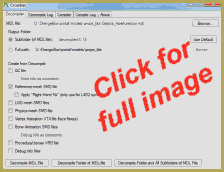 There are several tools that are able to do information technology, only I'd recommend Crowbar model decompiler, which requires less actions on user side, produces less junk files, and isn't prone to crashing, dissimilar other programs known to me. Setup its options as shown in the pic. Y'all may choose to decompile a unmarried model whose address yous feed to the plan, or all models in its dwelling house folder, with or without subfolders, at once (unfortunately, subfolder structure volition non exist preserved in the output binder). Depending on what 3D graphic programme will be using the decompiled product, there may be various types of files produced, only for creating .PMD files you will just need "Reference mesh SMD file" option. Hint: if you lot wish to decompile a item model, but not sure where to look for it, yous tin use Nem'due south Crafty Object Viewer to preview the .MDL file and ensure that it is indeed the one you're looking for (if you lot simply see empty screen when opening the file, press the downwardly arrow central to make the model shift into focus).
There are several tools that are able to do information technology, only I'd recommend Crowbar model decompiler, which requires less actions on user side, produces less junk files, and isn't prone to crashing, dissimilar other programs known to me. Setup its options as shown in the pic. Y'all may choose to decompile a unmarried model whose address yous feed to the plan, or all models in its dwelling house folder, with or without subfolders, at once (unfortunately, subfolder structure volition non exist preserved in the output binder). Depending on what 3D graphic programme will be using the decompiled product, there may be various types of files produced, only for creating .PMD files you will just need "Reference mesh SMD file" option. Hint: if you lot wish to decompile a item model, but not sure where to look for it, yous tin use Nem'due south Crafty Object Viewer to preview the .MDL file and ensure that it is indeed the one you're looking for (if you lot simply see empty screen when opening the file, press the downwardly arrow central to make the model shift into focus).
Stride 3: .SMD -> .PMD
At present it's time to actually utilize Blender. Launch it, select (right-click) the obligatory Cube Primitive that is loaded by default, and press Del to wipe it to oblivion. Choose File->Import->Source Engine (.smd, .vta, .dmx,.qc), and look for a model you need in a folder produced by Crowbar. And then select File->Export->MikuMikuDance Model (.pmd), and type a new file name into a respective field. Hint: in that location'due south a "Recent" panel on the left side of an Open/Salvage/Import/Export window. Y'all can utilise it to memorize recently used folders and chop-chop switch between them.
That'southward actually all you needed Blender for.
Footstep 4: Textures
 The model is practically set up, now you will need a texture to drape it. Start, you may install Windows VTF Shell Extensions, which allows yous to quickly browse folders with .VTF files right in Windows Explorer to find necessary files. Merely launch the programme, and then switch Explorer into Thumbnails mode. To actually open up files you need, though, y'all will demand a gimp-vtf plugin for GIMP. Open a file, and check GIMP'southward Layers window. If you lot come across that a file is presented by two picture thumbnail next, correct-click on whatever of them and select "Delete Layer Mask". Then save the picture equally a .PNG or .JPG file.
The model is practically set up, now you will need a texture to drape it. Start, you may install Windows VTF Shell Extensions, which allows yous to quickly browse folders with .VTF files right in Windows Explorer to find necessary files. Merely launch the programme, and then switch Explorer into Thumbnails mode. To actually open up files you need, though, y'all will demand a gimp-vtf plugin for GIMP. Open a file, and check GIMP'southward Layers window. If you lot come across that a file is presented by two picture thumbnail next, correct-click on whatever of them and select "Delete Layer Mask". Then save the picture equally a .PNG or .JPG file.
Your texture is ready.
So, what now?
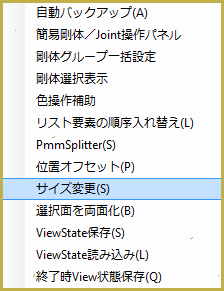
Edit->Plugin->System->▲THIS▲
Now that you have both a model and a texture, open the former in PMDE and assign the texture to a material in "Material" tab'south "Tex" field. Warning: if texture's name is longer than 10 symbols (not including the extension), the field will exist truncated next time y'all load the model and it'll look white once more. And if y'all programme to utilize a sphere to the model, and then the sum of *both* file names' lengths must not exceed x characters, otherwise the sphere will not be applied due to the then-called "Saizuo-bar!" bug. And so y'all meliorate sentinel your texture file name and rename it if necessary (you don't take to worry about it if you salve the model as .PMX, though). Next matter, yous will notice that the model is unusually large. Resize the model to a necessary size – a 0.ii coefficient is more than or less okay (the list of plugins is not translated in the new PMDE v0139, and then look at the motion-picture show to the left to discover the one you need).
10/08/2017:
 While working with Portal-based models, after some trial and error, I settled for 25*25 points to exist an optimal size for a standard cubic unit, both reasonably close to nigh regular MMD models' meridian and easy to utilize in calculations. For ripped models to match that size, yous'd need a resizing coefficient to be equal 0.1928. For other Source games, though, yous may need to find out your own value.
While working with Portal-based models, after some trial and error, I settled for 25*25 points to exist an optimal size for a standard cubic unit, both reasonably close to nigh regular MMD models' meridian and easy to utilize in calculations. For ripped models to match that size, yous'd need a resizing coefficient to be equal 0.1928. For other Source games, though, yous may need to find out your own value.
What you may find next… is that the model already has basic! That's right, the described combination of plugins and programs provides you not merely with the shape of the model itself, simply with semi-rigged *and* weighted bone structure likewise. Of course, y'all'll have to refine information technology to work well in MMD surround (for one matter, all bones take parent but not kid bones assigned to them; sometimes not even parent ones), simply yous can't argue that the biggest part of work is already cut out for you. If the model has *no* bones while you believe it must, check the binder where you got it. Some models use several .MDL files that represent it, with names that have different tail parts. Try the procedure with another one and encounter if the result is amend.
Finally, before y'all actually start doing anything else with the model in PMDE, save it and try to load information technology into MMD. It may happen that instead of the model you merely get an empty bone that doesn't fifty-fifty respond to moving. Again, check the binder with .MDLs. There must be another version of a file that works properly.
And that'southward all you need to first your own Combine invasion to take over MikuMikuDance! Go alee, you know you want to.
– SEE BELOW for More MMD TUTORIALS…
![]()
More MMD Tutorials...
Source: https://learnmmd.com/http:/learnmmd.com/import-models-source-engine-based-games-hl2-portal-tf2-etc/
0 Response to "How to Upload Mmd Models Into Other Software"
Post a Comment